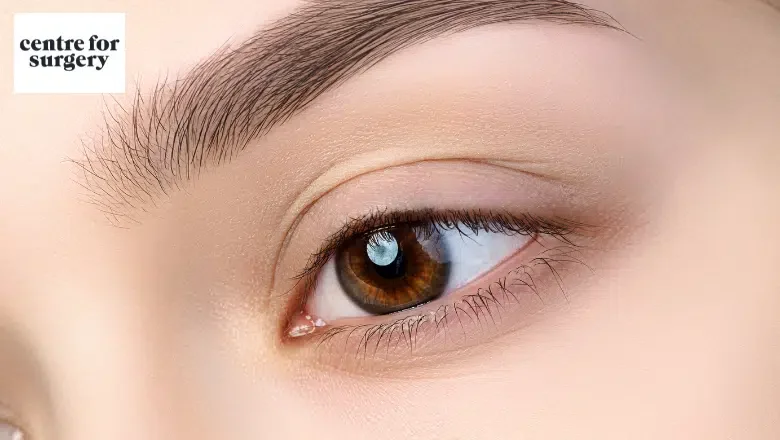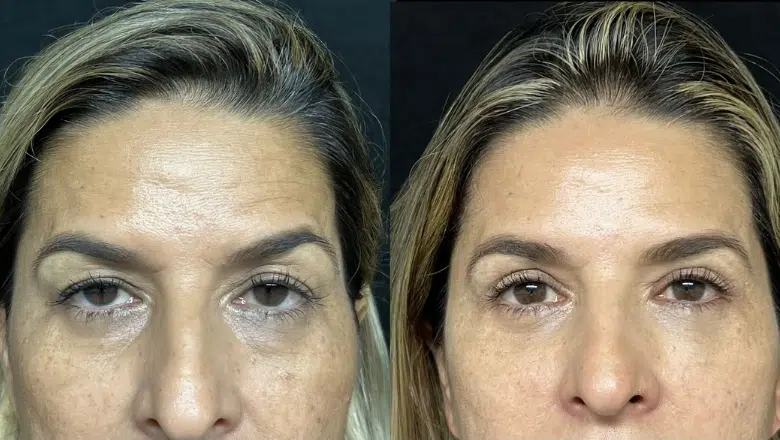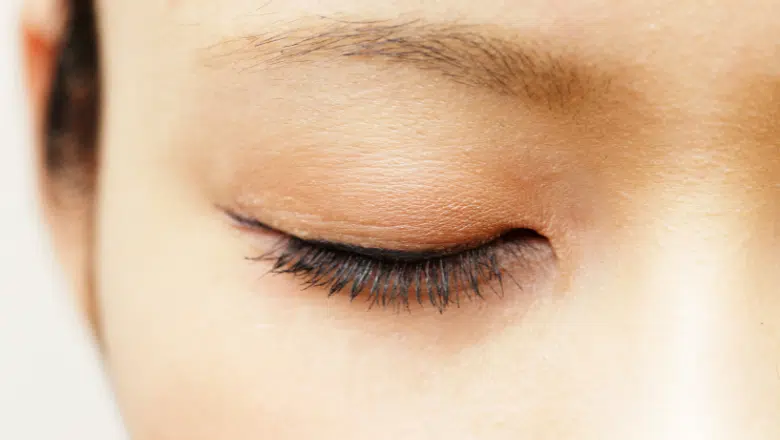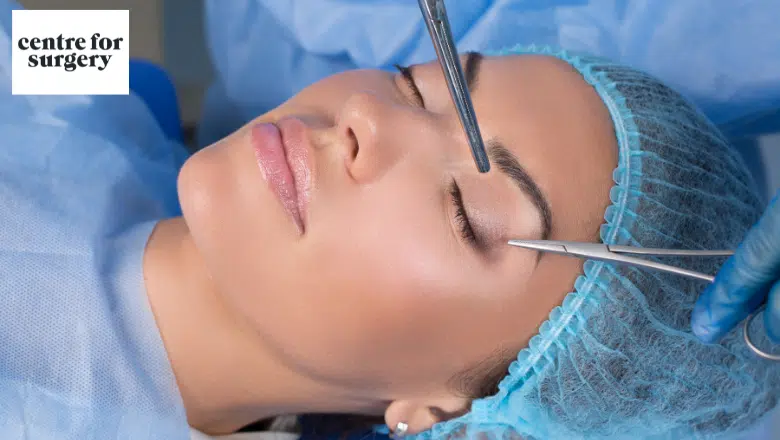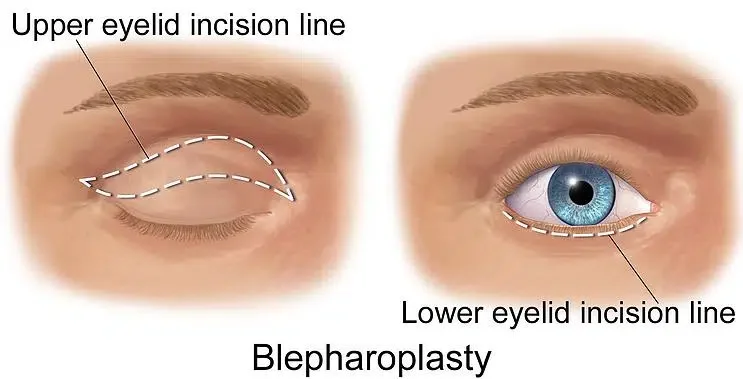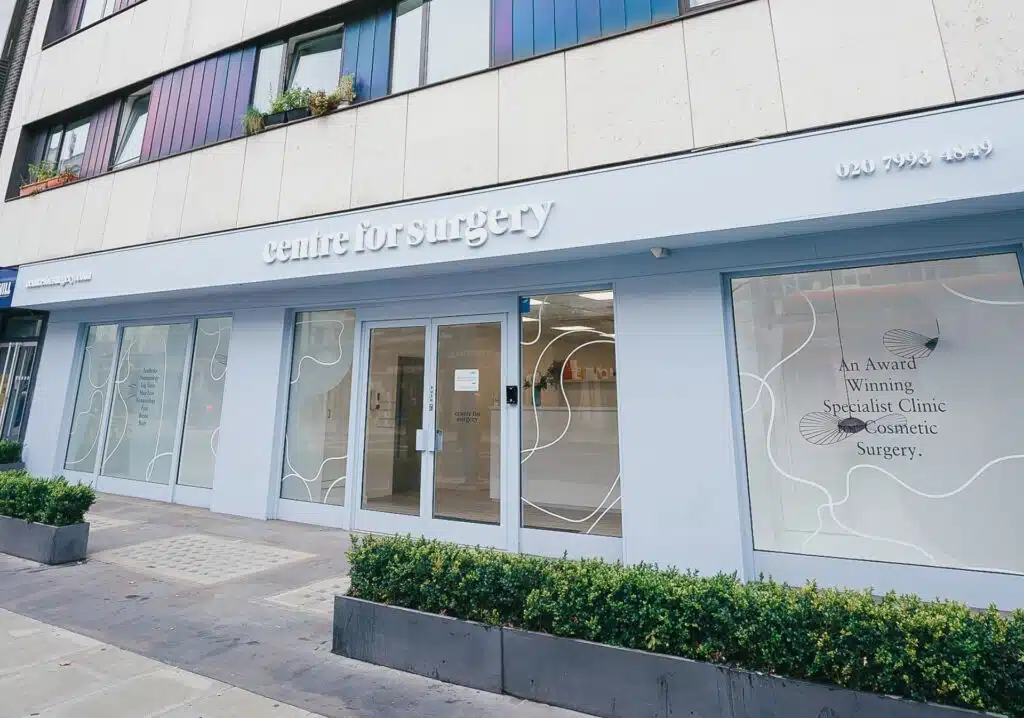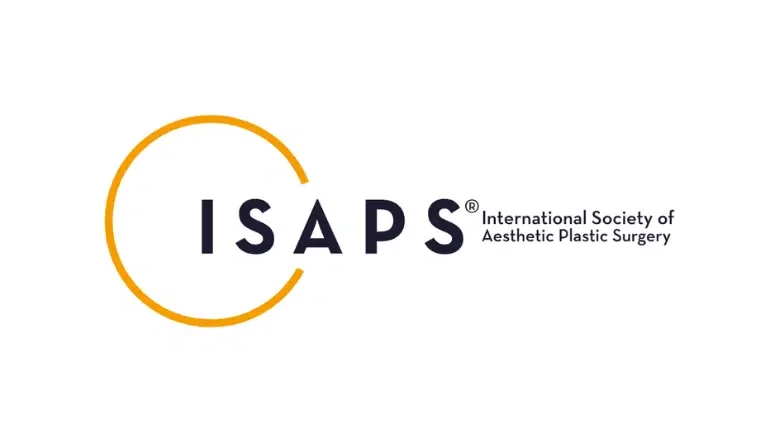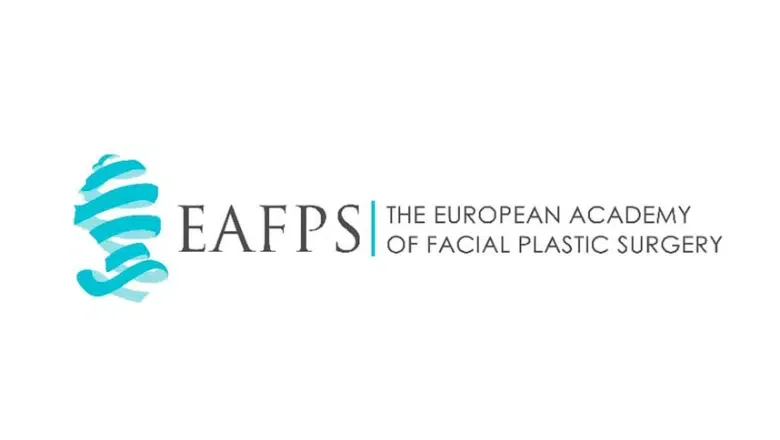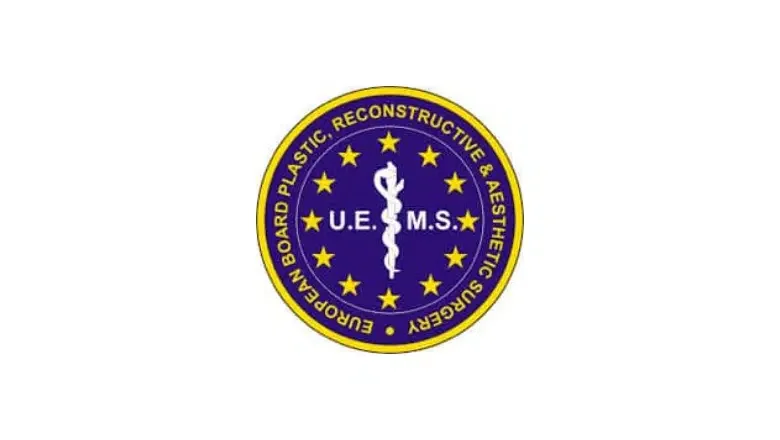Blepharoplasty & Eyelid Surgery in London UK
The eyes are said to be the windows to the soul, but unfortunately, they are also one of the first places where the signs of ageing become apparent. As we age, the skin around our eyes begins to lose its elasticity, causing it to wrinkle and sag, resulting in a tired and aged appearance.
Fortunately, advancements in plastic and cosmetic surgery have made it possible to restore a more youthful appearance around the eyes through blepharoplasty or eyelid surgery. This surgical procedure involves removing excess skin and fatty tissue from the eyelids to eliminate bags underneath the eyes and reduce the hood of skin that can form on the upper eyelids. Additionally, the surgery can also smooth out the crow’s feet wrinkles that tend to form at the corners of the eyes.
RELATED: Trifecta Lift: The Threefold Approach to Replacement, Restoration and Refinement
When performing eyelid surgery, our surgeons carefully consider the individual’s facial structure and desired outcome to determine the most suitable surgical approach. The procedure can be performed on the upper eyelids, lower eyelids, or both, depending on the extent of the sagging and wrinkling.
For many individuals, the results of eyelid surgery are remarkably rejuvenating, making them appear years younger. Not only does this cosmetic surgery restore a more youthful appearance, but it can also help individuals regain their self-confidence and feel more comfortable in their own skin.
What is Eyelid Surgery (Blepharoplasty)?
Blepharoplasty is a cosmetic surgical procedure designed to enhance the appearance of the upper and lower eyelids. This procedure can address various issues such as excess skin, wrinkles, puffiness, bags, and fatty deposits that can make a person look tired and older or give an unflattering appearance to the eyes.
A plastic or oculoplastic surgeon performs the procedure, which can be done on the upper eyelids, lower eyelids, or both, depending on the patient’s specific needs and goals. During the procedure, the surgeon will remove excess skin, fat, and muscle, and then tighten the remaining tissue to create a smooth and youthful appearance.
Types of Blepharoplasty Procedures
Blepharoplasty is a versatile cosmetic surgery that can be customised to fit the specific needs of each patient. Several types of blepharoplasty procedures can target different areas of the eyes and achieve various aesthetic goals. Here are some of the most common types of blepharoplasty procedures:
Upper Eyelid Surgery
This procedure is designed to address the excess skin and fat on the upper eyelids, which can cause drooping and make the eyes look tired. During the surgery, the surgeon will make an incision along the natural crease of the eyelid and remove the excess tissue, tightening the skin and giving the eyes a more youthful and refreshed appearance.
Lower Blepharoplasty
This procedure focuses on the lower eyelids, specifically the bags and puffiness that can form beneath the eyes. The surgeon will make an incision either inside the lower eyelid or along the lash line, removing excess fat and tissue to smooth out the area and reduce the appearance of bags and dark circles.
Lateral Canthoplasty
Also known as almond eye surgery, this procedure is typically performed on patients with narrow or small eyes. The surgery involves creating an elongated outer corner of the eye by cutting and repositioning the outer corner of the eyelids. This results in a more almond-shaped eye and a wider, more open appearance.
Asian Blepharoplasty
This procedure is specifically designed for patients of Asian descent who may have different anatomical features than those of other ethnicities. The surgery involves creating a double eyelid by removing excess tissue and creating a natural crease on the upper eyelid.
Male Blepharoplasty
Men may also benefit from blepharoplasty procedures to address signs of ageing or other aesthetic concerns around the eyes. Male blepharoplasty typically involves a more subtle approach to ensure a natural-looking result that doesn’t appear too feminine.
RELATED: Traditional vs Non-Surgical Approach
Before & After Photos - Real Patient Results
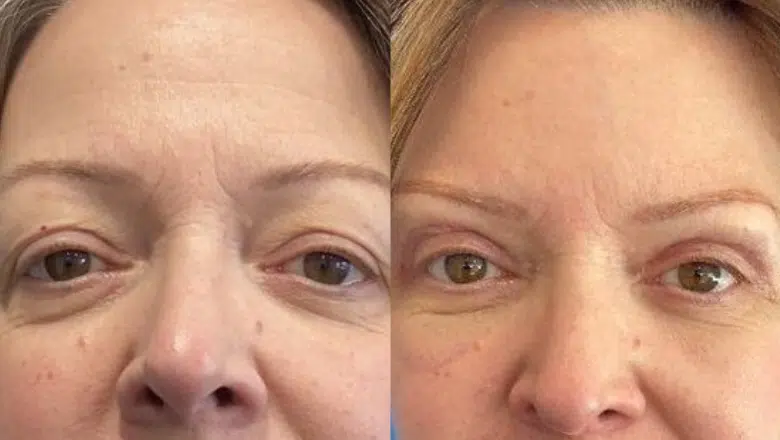
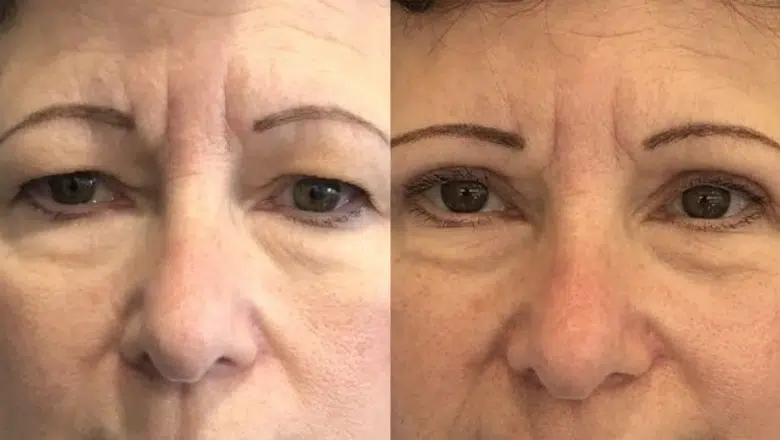
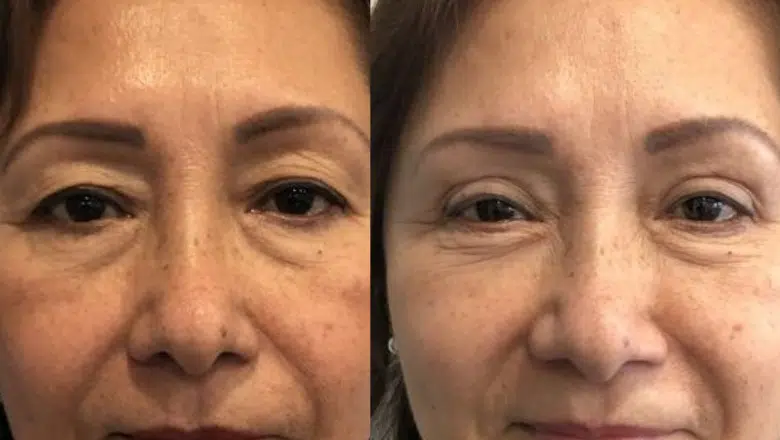
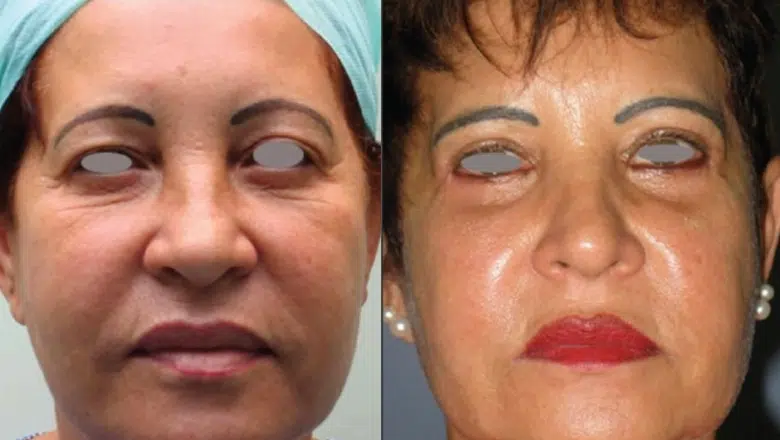
Why Patients Might Consider Eyelid Surgery (Blepharoplasty)
The procedure can target a variety of conditions, including:
Excess skin
As we age, the skin on the eyelids can lose elasticity, causing it to droop or sag. Blepharoplasty can remove this excess skin, giving the eyes a more youthful and alert appearance.
Puffy or “bags” under the eyes
Fat accumulation in the lower eyelids can create a puffy or “baggy” appearance. Blepharoplasty can remove this excess fat to reduce puffiness and create a more rested and refreshed look.
Hooded eyelids
The skin on the upper eyelids can droop, creating a hooded appearance that makes the eyes appear smaller or less open. Blepharoplasty can remove excess skin and fat to lift the upper eyelids, creating a more alert and youthful appearance.
Obstructed vision
In some cases, excess skin on the upper eyelids can obstruct vision. In these cases, blepharoplasty may be performed for functional rather than cosmetic reasons.
Wrinkles and fine lines
While blepharoplasty is not explicitly designed to address wrinkles and fine lines, the procedure can improve the appearance of the eyelids, making wrinkles and fine lines less noticeable.
Non-surgical options, such as SmoothEye Laser, can also be considered an alternative to achieve eyelid tightening results.
Am I Suitable?
Ideal candidates for blepharoplasty surgery include:
- Individuals with excess skin on their upper eyelids that obstruct their vision.
- People with puffiness or bags under their eyes that make them look tired or older.
- People who have wrinkles or fine lines around their eyes that make them look older or tired.
- Individuals with a genetic predisposition to excess skin or fat on the eyelids.
- People who are in generally good health and have a positive outlook and specific goals for the surgery.
- People who have realistic expectations about the outcome of the surgery and understand the risks and limitations of the procedure.
Blepharoplasty is not recommended for people with serious eye conditions, such as glaucoma or severe dry eyes, or for those who have a history of keloids or poor healing. People with active eye infections or allergies should also avoid this procedure.
Preparing for Blepharoplasty
Surgery Techniques
The procedure typically involves the following steps:
Anaesthesia
Before the procedure, the patient will be given either local anaesthesia with oral sedation or general anaesthesia. Local anaesthesia numbs the area around the eyes, while general anaesthesia puts the patient to sleep. The procedure typically takes between 1 and 2 hours, and patients can usually go home the same day.
Incision
The surgeon will make a small incision along the natural crease of the upper eyelid or just below the lashes of the lower eyelid. Through this incision, the surgeon will remove excess skin, fat, and muscle as needed.
Reshaping
After removing the excess tissue, the surgeon will reshape the eyelids to create a more youthful and refreshed appearance. This may involve repositioning or removing fat or removing excess skin or muscle.
Closing the incision
The incision will then be closed with sutures, surgical glue or tape, and/or skin adhesive.
RELATED: What Does Eyelid Surgery Involve?
Recovery after Eyelid Surgery (Blepharoplasty)
Recovery after blepharoplasty can vary depending on the extent of the procedure and the individual’s overall health. However, there are some general guidelines that can be followed to promote healing and minimise discomfort during the recovery process.
RELATED: Recovery after Surgery – Top Tips
Immediately following the surgery, patients may experience swelling and bruising around the eyes, which can typically be managed with cold compresses and over-the-counter pain medication. It’s essential to keep the head elevated for the first few days to reduce swelling and to avoid strenuous activity, such as bending or lifting.
RELATED: How to Reduce Bruising and Swelling
Stitches will be removed within the first week, and most patients can return to work and normal activities within one to two weeks, depending on the type of procedure. However, strenuous activities should be avoided for several weeks to prevent complications.
Patients should also avoid exposing their eyes to the sun or wind and use sunscreen to protect their skin from damage during healing. It’s also important to follow any additional instructions the surgeon provides, such as keeping the eyes clean and using eye drops as directed.
It’s normal for the eyes to feel dry and itchy for the first few weeks after the surgery, but these symptoms should improve as the eyes heal. Patients should also be aware that the final results of the surgery may not be obvious for several months as the swelling and bruising subside.
Blepharoplasty scars
One of the concerns that patients may have about the procedure is the appearance of scars after the surgery. Here is what you should know about blepharoplasty scars:
Location of the scars
The incisions for blepharoplasty are typically made along the natural crease of the upper eyelid or just below the lashes of the lower eyelid. These incisions are carefully placed in areas where they are less visible and are well-concealed by the natural contours of the eyelids.
Size and appearance of the scars
The size and appearance of the scars will depend on the extent of the procedure and the individual healing process. In most cases, the scars are small and well-hidden. They may be slightly red or pink for the first few weeks, but will typically fade over time.
Healing process
It’s essential to follow the post-operative instructions provided by your surgeon to ensure proper healing and minimize the risk of complications such as infection or scarring. Your surgeon will also provide you with information on how to care for the incision site and reduce the appearance of the scars.
Scar treatment
In some cases, scar treatment may be required to improve the appearance of the scars. Options include silicone gel or silicone sheets, or other topical treatments such as topical retinoids, silicone-based products, or vitamin E oil.
Final results
It’s important to note that the final results of blepharoplasty, including the appearance of the scars, may not be visible for several weeks or months as the swelling and bruising subsides.
Eyelid Surgery Costs London - How much does Blepharoplasty Cost in London UK? Prices & Fees
The cost of eyelid surgery in the UK can vary depending on several factors, such as the experience of the surgeon and the extent of the procedure.
The average cost of eyelid surgery in the UK is around £2,000 to £4,000 for upper eyelid surgery and £3,000 to £5,000 for lower eyelid surgery. It is important to note that the cost of the procedure is not covered by the National Health Service (NHS) in the UK, as it is considered a cosmetic procedure.
Remember that the cheapest surgeon is not always the best choice. Choose a qualified, experienced and reputable plastic surgeon who has good reviews and testimonials and who is a member of the British Association of Aesthetic Plastic Surgeons (BAAPS) or the British Association of Plastic, Reconstructive and Aesthetic Surgeons (BAPRAS) or their international equivalents.
There are also financing options available for eyelid surgery, such as medical loans, which can help make the procedure more affordable.
Centre for Surgery is fully approved to offer finance for eyelid surgery via our specialist finance partner, Chrysalis Finance. You no longer need to use your savings to pay for your treatment – you can apply to spread the cost of your procedure with Chrysalis Finance using their simple 1,2,3 application to pay for your procedure. Don’t wait until you have enough money for your treatment. Apply today and (subject to status) pay for your procedure easily in monthly instalments using one of their payment options. Chrysalis Finance is the only ethical provider that focuses solely on providing specialist financing for medical and cosmetic surgery procedures.
Why Choose Centre for Surgery
FAQs
-
What is eyelid reduction?Eyelid reduction, synonymous with blepharoplasty, specifically refers to surgical techniques aimed at enhancing the eye's appearance. This procedure is not just about removing excess skin; it involves tightening, reshaping, and lifting the eyelid skin to revitalise the area surrounding the eyes. Remarkably, the transformation can be achieved in as little as 45 minutes, making it a convenient option for both men and women seeking significant cosmetic improvement with minimal downtime. Eyelid reduction is a tailored approach to meet individual aesthetic goals, offering a bespoke solution for those looking to combat the signs of ageing or genetic predispositions affecting the eyelids.
-
What is blepharoplasty?Blepharoplasty is also known as eyelid reduction, eye lift and eye bag removal. Eyelid surgery targets the upper and lower eyelids for enhanced peri-ocular rejuvenation. Upper blepharoplasty and lower blepharoplasty target the eyelids to address ageing changes in the skin, underlying muscle and eye region. Eyelid surgery is ideally suited for older patients aged 50 and older but is often necessary for younger patients particularly when there are underlying structural issues such as drooping of the eyelids, eyelid lumps or puffy eyelids. Excess fat deposits which bulge outwards can also be addressed. These are known as eye bags and can develop earlier in life. Eyelid surgery can also be commonly performed with other facial cosmetic procedures such as a brow lift, facelift or facial fat transfer.
Facial fat transfer or fat grafting is very commonly combined with eyelid surgery particularly when there is volume loss in the upper or lower eyelids. -
What is an Asian blepharoplasty?Asian blepharoplasty is a type of blepharoplasty surgery that creates a crease in the upper eyelid when the crease is absent. Many Asian men and women choose to have this procedure to increase the definition of the eyes.
-
What Are the Genetic Reasons for Opting for Eyelid Surgery?Eyelid surgery, or blepharoplasty, often finds its necessity rooted in genetics. Many individuals inherit specific cosmetic concerns that prompt them to consider this procedure. Common genetic issues include lumps on the eyelids, which can be both unsightly and uncomfortable, and ptosis, a condition where the eyelids droop, obscuring vision and altering appearance. Some are born with a predisposition towards having sunken eyes or developing dark circles and bags under the eyes at an early age. Blepharoplasty can address these conditions effectively, offering a solution to these inherited traits by rejuvenating the eye area and restoring a more youthful, refreshed look.
-
What are saggy eyelids?Sagging eyelids are one of the most obvious signs of the ageing process in both men and women. The presence of sagging eyelids can be a source of psychological distress especially when the perception exists that you feel you look older than one's actual age. Droopy eyelids can also lead to a sad or angry-looking appearance which may be remarked upon by others. In more severe cases of eyelid sagging, functional disturbance can result from impairment to vision from eyelids that droop too low.
Sagging eyelids can be caused by a number of factors but the most significant factor is the ageing process which exerts its effects through a loss of tissue firmness. In the eyelid region, the levator muscle acts to elevate the eyelid but with ageing, the levator muscle begins to thin out which leads to stretching of the overlying skin and deeper fat pockets begin to herniate outwards.
Droopy eyelids are more likely to happen in some individuals as they may have a hereditary link to forming droopy eyelids and this can affect both eyelids equally or one eyelid may be affected more than the other. Other extrinsic factors which can contribute to eyelid sagging or drooping include chronic sunlight exposure. -
How do saggy eyelids develop?During the ageing process, the skin will gradually lose collagen, which results in a reduction in skin elasticity. A combination of loss of skin elasticity combined with the effects of gravity will cause the skin to descend and lead to sagging.
With the eyelids, the edges of the upper eyelids will descend first. The small tendon of the eyelid muscle, which normally functions to lift the upper eyelid, will also undergo stretching. The upper eyelid muscle will therefore struggle to lift the upper eyelid properly.
With continued ageing, the loss of elasticity and muscle atrophy act in concert to create the appearance of a droopy upper eyelid. Those who habitually rub their eyes or have a degree of eyelid retraction will also lead to laxity of the upper eyelids. Ophthalmic surgery, such as cataract surgery, is a common cause of droopy eyelids. The reason for this lies in the stretching of the eyelid to keep the eye open during surgery leading to muscle atrophy or weakening. Droopy eyelids or eyelid ptosis can also be present from birth, which is then referred to as congenital ptosis.
On top of the development of eyelid laxity, the ageing process also affects the entire face. The most noticeable feature of facial ageing is often a loss of facial volume. This may make bony structures on the face appear more prominent. When the cheeks begin to descend, the aged appearance of the lower eyelids can be more evident due to the development of hollowness. -
What causes eyelid sagging?Several factors can contribute to eyelid sagging, also known as ptosis. These include:
Ageing: As we age, the skin and muscles in the eyelids can weaken and lose elasticity, leading to sagging and drooping of the eyelids.
Genetics: Some people may have a genetic predisposition to eyelid sagging, which may run in families.
Neurological conditions: Certain neurological conditions, such as myasthenia gravis or Horner's syndrome, can cause eyelid sagging due to muscle weakness or dysfunction.
Trauma or injury: Trauma to the eye or surrounding area, such as a blow to the head, can cause eyelid sagging.
Previous eyelid surgery: Sagging can occur as a complication of eyelid surgery, such as blepharoplasty.
Eyelid tumours or cysts: Tumours or cysts on the eyelid can cause the eyelid to droop.
It's important to note that eyelid sagging can also be a normal part of the ageing process, and does not always indicate a serious underlying condition. Consultation with an oculoplastic surgeon or plastic surgeon at Centre for Surgery is the best way to determine the cause of eyelid sagging and the appropriate treatment options. -
Is it possible to get rid of eye bags?Yes, through Blepharoplasty: The surgeon can remove excess fat by making an incision either in the natural crease of the upper eyelid or inside the lower lid. This procedure can effectively treat baggy or puffed-up upper eyelids.
-
Can eyebags be treated with a blepharoplasty?Eyebags are often due to excess skin and these can be treated effectively with a lower blepharoplasty procedure.
-
Can fine lines and wrinkles around the eyes be treated with a blepharoplasty?Peri-ocular wrinkles around the eye region are most effectively treated with ablative laser skin resurfacing using erbium laser, not a surgical blepharoplasty.
Centre for Surgery specialises in both fractional and full-field laser resurfacing using the state-of-the-art Erbium YAG laser. -
How to choose the best blepharoplasty surgeonEyelid reduction surgery is also known as blepharoplasty and is a highly specialised area of facial plastic surgery. It is therefore vital that you select the right type of surgeon to carry out this highly intricate type of cosmetic surgery procedure.
In our view, facial plastic surgeons are the most qualified type of surgeon to carry out all types of eyelid surgery, both aesthetic and reconstructive. Facial plastic surgeons have carried out extra years of training under the instruction of some of the world's leading experts in facial plastic surgery. General plastic surgeons do not have the same level of expertise and skill compared with specialist facial plastic surgeons.
The facial plastic surgeon is best placed to explain all aspects of the eyelid reduction procedure in detail and give information on what to expect in the recovery period after surgery and the potential risks and complications of eyelid reduction surgery. They will be able to determine if your expectations for Surgery are realistic and if you are in the best health, both physical and mental, for cosmetic eyelid surgery.
You should make sure to ask your surgeon to see their portfolio of before and after blepharoplasty images especially of patients that are similar to yourself to give you an accurate idea of how you could look after eyelid reduction surgery. You should also view verified patient reviews on trusted review platforms such as Trustpilot.
As part of your research, be sure to check the surgeon's accreditations on the GMC website. Your surgeon should be on the specialist register and belong to a specialist organisation such as the European Academy of Facial Plastic Surgery or its equivalent. -
What is the surgical procedure to repair drooping eyelids?Blepharoplasty: This is commonly referred to as an 'eyelid lift'. It's a surgical procedure designed to address sagging or drooping upper eyelids (known medically as ptosis). During this operation, the surgeon removes excess skin from the eyelids to provide a rejuvenated appearance.
-
How can droopy lower eyelids be corrected?Lower Eyelid Surgery (Canthopexy): If your lower eyelids sag or droop, perhaps because of sun damage, previous surgeries, ageing, or paralysis, Canthopexy can help. This surgery is specifically designed to tighten and, in certain cases, elevate the lower eyelids.
-
How is lower eyelid surgery performed?During the surgery, if both upper and lower eyelids are being treated, surgeons usually start with the upper lids. The procedure involves making an incision along the eyelid's fold, extracting some excess skin, muscle, and at times, fat, and then stitching up the incision.
Whether it's age, genetics, or environmental factors causing eyelid concerns, today's advanced surgical techniques offer effective solutions to help you achieve a refreshed and youthful look. -
What solutions are available for droopy eyelids?If the drooping of your eyelid hinders your vision, medical intervention might be necessary. Often, doctors suggest undergoing surgery. However, for temporary droopiness, a ptosis crutch (a type of glasses) could be used to hold up the eyelid.
-
Am I a good candidate for blepharoplasty?You must have realistic expectations because although eyelid surgery can improve your appearance, other people may not always notice it. The procedure is suitable for both men and women with most patients being over 30. However, droopy eyelids can also be hereditary so those may consider eyelid surgery at a younger age.
-
What side effects are associated with blepharoplasty?After the blepharoplasty procedure, it is common to experience puffy eyelids due to postoperative swelling but fortunately, the serious risks of blepharoplasty are rare. It can be difficult to fully close the eyes at night when sleeping and this can last up to 3 days. Watery and irritated eyes are commonly experienced for a number of weeks but this will subside without any long-term impairment. Bruising of the eyelids can develop which can resemble a black eye and the incision scars may be raised and red for the first week. The surgeon will inject local anaesthetic and may apply topical local anaesthetic eye drops before starting the procedure and this may result in blurred vision due to residual effects of the local anaesthetic. At your consultation for eyelid surgery, your plastic surgeon will explain the potential risks and complications associated with the procedure and the potential chances of them occurring.
-
What is the best way to prepare for eyelid surgery?At your face-to-face consultation with your blepharoplasty surgeon, the surgeon will explain in detail the important preoperative instructions to enable an excellent outcome following blepharoplasty surgery. In some cases, you may be asked to have an eye examination if you have a history of conditions affecting your eye. Your eyes will also be physically examined and standardised photography will be taken off the eyes from a number of angles.
It is recommended to stop smoking two weeks before the procedure. Smoking has a negative effect on wound healing and leads to an increase in the risk of postoperative complications occurring.
You may also be advised to stop taking aspirin or any medicines containing aspirin and herbal supplements should also be stopped. These medicines are associated with an increased risk of bleeding after eyelid surgery. This is particularly important after a lower blepharoplasty with fat repositioning where it is vital that the risk of postoperative haematoma is minimised as much as possible. -
Is general anaesthesia used for eyelid surgery?Yes, for some eyelid surgeries, you'll be administered a general anaesthetic through an IV injection, ensuring you're asleep throughout the procedure. The duration you're under can range from a brief 20 minutes to a longer period of up to two hours, depending on the surgery's intricacy and if both the upper and lower eyelids are being treated.
-
How long does eyelid surgery take to perform?From 1 hour for an upper blepharoplasty to 3 hours for a combined blepharoplasty.
-
What are the different types of eyelid surgery?Upper eyelid surgery:
Procedure duration: 1 - 1.5 hours
Type of incision: Eyelid crease incision
Anaesthetic: Local anaesthetic or general anaesthetic
Recovery period: Day case and minimal downtime
Lower eyelid surgery:
Procedure duration: 1.5 - 2 hours
Type of incision: Transcutaneous (below the eyelashes) or transconjunctival (inside the lower eyelid)
Anaesthetic: General anaesthetic recommended
Recovery period: Longer than an upper blepharoplasty. Depends on the individual.
Combined eyelid surgery (upper and lower eyelids):
Procedure duration: Approximately 3 hours
Type of incision: As above
Anaesthetic: General anaesthetic is compulsory
Recovery period: As for a lower blepharoplasty with 2-3 days extra. -
Where are the incisions placed?Upper blepharoplasty - eyelid crease
Lower blepharoplasty - inside the lower eyelid or below the lower eyelash -
Is blepharoplasty painful?Blepharoplasty or eyelid surgery is a superficial procedure in that it involves the removal of excess skin and does not involve any deeper work. There is, therefore, very little in the way of post-operative discomfort during the recovery period. Any pain can be controlled with simple over-the-counter painkillers and the application of antibiotic eye ointment prescribed by your surgeon.
In most cases, patients require no pain relief whatsoever after eyelid surgery. It is common to have a feeling of grittiness in the eyes, and this is effectively treated with the eye ointment prescribed to you to take after the surgery. It is common to have a bruised and swollen appearance after surgery, although this rapidly settles down after a few days. Most patients often work from home for a day or two after surgery and are back to their normal activities of daily living after 3 to 4 days. Any post-operative discomfort is very insignificant in nature. -
Can brow ptosis (droopy brow) be treated by blepharoplasty?Brow ptosis requires a brow lift, and if blepharoplasty surgery is contemplated for eyelid laxity, then it is recommended that the browlift is performed first.
Browlifts can reduce forehead creasing and also frown lines. It can also reposition the brow up to 1cm higher to provide excellent correction of low-lying drooping brows. -
Can eyelid surgery be combined with other procedures?Blepharoplasty surgery is very often combined with other facial procedures, such as a facelift, laser resurfacing or facial fat transfer.
-
What does the blepharoplasty procedure involve?At Centre for Surgery in London, blepharoplasty is a very commonly performed procedure and is always carried out as a day-case procedure which means you will be admitted and discharged on the same day. Most eyelid surgery is carried out under our form of general anaesthetic known as TIVA. However, if you are having only an upper blepharoplasty, then it may be possible to carry this out under a local anaesthetic. Eyelid surgery takes, on average, between 45 minutes and two hours to carry out, depending on the extent of the work performed.
- Upper Blepharoplasty
Upper eyelid blepharoplasty is primarily carried out to reduce or eliminate visual impairment caused by droopiness of the upper eyelids caused by ageing. The upper eyelid blepharoplasty procedure aims to restore a healthy, youthful and vibrant appearance to the upper eyelids. The incision for upper blepharoplasty is located along the natural eyelid crease, followed by the removal of extra redundant skin and herniated fat pockets or the removal of excess muscle laxity. Before closing the skin with sutures, the skin is stretched out to remove any overlying lines and wrinkles. The resulting scar after upper blepharoplasty is very well concealed in the natural fold of the eyelid, which makes it barely perceptible to others after a few weeks.
Procedure duration: 1 - 1.5 hours
Type of incision: Eyelid crease incision
Anaesthetic: Local anaesthetic or general anaesthetic
Recovery period: Day case and minimal downtime
- Lower blepharoplasty
Lower eyelid blepharoplasty is most commonly carried out to reduce or eliminate localised eyelid wrinkles and eyelid puffiness in the area beneath the eye. The incision for lower eyelid blepharoplasty is positioned just below the eyelash margin and extends outwards into the lateral canthal lines, also known as the crow's feet. In some cases, in patients with minimal skin excess, your surgeon may carry out a trans-conjunctival approach using CO2 laser dissection to expertly reposition the herniated fat pads giving rise to visible bags under the eyes. The advantage of this approach is that it does not involve any visible scar, as the incision is well concealed in the conjunctiva.
Procedure duration: 1.5 - 2 hours
Type of incision: Transcutaneous (below the eyelashes) or transconjunctival (inside the lower eyelid)
Anaesthetic: General anaesthetic recommended
Recovery period: Longer than an upper blepharoplasty. Depends on the individual.
Combined blepharoplasty (upper and lower eyelids)
Procedure duration: Approximately 3 hours
Type of incision: As above
Anaesthetic: General anaesthetic is compulsory
Recovery period: As for a lower blepharoplasty with 2-3 days extra. -
Is blepharoplasty painful?Post-operatively, your doctor will ensure you're provided with appropriate pain relief medications to keep discomfort at bay. Following the surgery, it's typical for the eyelids to display some swelling and bruising. This can persist for 1 to 3 weeks. Over the subsequent 1 to 3 months, the appearance of your eyes should progressively improve.
-
How long does it take to recover from blepharoplasty?Recovery from blepharoplasty is generally swift, but it's important to note that since the procedure involves the central facial area, any dressings, bruising, or swelling will be visible. While some individuals might feel comfortable continuing with their day-to-day activities, engaging in physical exercise is not recommended during the initial recovery phase as it can exacerbate bruising and swelling, potentially prolonging recovery. Opting to work from home is a practical choice, with the understanding that bruising, particularly around the lower eyelids, typically subsides within 10 days. Upper eyelid recovery is usually quicker, and any bruising can be concealed with makeup, following professional advice on cosmetic camouflage.
For those who are particularly conscious about their appearance post-surgery, taking a two-week break before returning to social or work settings is advisable. Stitches are typically removed within the first week, and it's normal to experience slightly blurred vision initially due to the surgery, the use of local anaesthesia, and the ointment applied inside the eyelid, which can obscure vision to some extent.
Specifically, surgery on the lower eyelids can lead to prolonged swelling or chemosis, where swelling extends under the conjunctiva onto the eyeball, causing the eye to appear watery for several weeks. Additionally, bruising under the conjunctiva can result in bright red haemorrhages, though these issues are more cosmetic and temporary rather than medically concerning. Swelling might also lead to ectropion, a condition where the lower eyelid pulls away from the eyeball, which, while bothersome, typically resolves on its own within a few days or weeks. -
How can I speed up my recovery after eyelid surgery?Several steps can help speed up recovery after eyelid surgery, known as blepharoplasty.
First and foremost, follow your surgeon's postoperative instructions carefully. These guidelines are essential for healing and reducing the risk of complications. Instructions may include keeping your head elevated, avoiding strenuous activities, and applying cold compresses to reduce swelling.
Managing pain and swelling is also crucial. Post-surgery, it’s common to experience pain and swelling, but you can manage these with over-the-counter pain relief and cold compresses. Applying a cold compress to your eyes for 20-30 minutes multiple times a day can significantly reduce swelling and discomfort.
Maintaining clean and moisturised eyes is vital for a speedy recovery. Your surgeon will provide specific instructions for eye care, which are important to follow to prevent infection. Using artificial tears or eye drops can help keep your eyes lubricated, reducing dryness and itching.
Protecting your eyes from sun and wind exposure is crucial in the initial weeks following surgery. Avoiding these elements can minimise the risk of complications and aid in healing. Wearing sunglasses can shield your eyes from harmful UV rays and wind.
Ensure you get plenty of rest and avoid vigorous activities during your recovery. Adequate sleep and taking it easy will help your body heal faster.
Smoking can delay the healing process and increase the risk of complications. It's best to refrain from smoking for at least two weeks before and after your surgery. -
When can I return to work after eyelid reduction?We would advise 7-14 days off work.
A responsible adult escort should take you home after surgery and look after you for the first 24 hours. -
When can I resume driving after blepharoplasty surgery?After undergoing blepharoplasty (eyelid surgery), it's essential to ensure you're fit and safe before taking up activities like driving. Here are some factors to consider:
Vision Clarity: After the surgery, swelling and bruising can obstruct vision, making it unsafe to drive. You'll need to ensure that your vision is clear and unobstructed before getting behind the wheel.
Medication Effects: Post-surgery, you may be on painkillers or other medications that can impair your judgment, reflexes, or make you drowsy. It's crucial not to drive while under the influence of any medication that can affect your ability to operate a vehicle safely.
Physical Strain: Driving can involve a certain degree of physical effort and quick movements, especially in busy traffic conditions. As bending and heavy lifting are discouraged for a week to 10 days post-surgery, it's also wise to consider how comfortable and agile you feel before deciding to drive.
Doctor's Advice: Always follow your surgeon's advice. They will provide guidelines based on your individual recovery progress. Some people might be ready to drive sooner, while others may need to wait a bit longer.
Legal Implications: Remember that if you drive while impaired and get into an accident, there may be legal consequences. Always ensure you're in a fit state to drive.
In general, while many patients might feel ready to drive just a few days after their blepharoplasty, it's essential to ensure safety first, considering all the above factors. If in doubt, ask someone else to drive, or use public transport or taxis until you're confident in your ability to drive safely. -
When can I resume going to the gym after eyelid surgery?Light exercise can be resumed after 2-3 weeks.
Strenuous exercise and contact sports may be restarted after 6 weeks. -
Can I wear glasses or contact lenses after blepharoplasty?You can wear glasses as normal following your procedure. Contact lenses will require a period of at least 2-3 weeks before they can be used again.
-
Can make-up be applied straight after eyelid surgery?You should wait at least 8-10 days before wearing eyeshadow, mascara, eyeliner and fake lashes.
-
What is the scarring like after blepharoplasty?Scarring is minimal, and the scars will become almost invisible when the eyes are open.
-
How long do the results of eyelid surgery last?Upper Eyelid Surgery: The results from upper eyelid surgery generally last between five to seven years. If, after that period, sagging reappears, other procedures like a forehead lift might be more beneficial than undergoing another eyelid surgery.
Lower Eyelid Surgery: The effects of lower eyelid surgery tend to be longer-lasting and it's rare for patients to need a repeat procedure. -
Is eyelid surgery permanent?The changes from eyelid surgery (blepharoplasty) are generally considered permanent. Still, the effects of ageing and gravity will eventually cause drooping and sagging in the upper and lower eyelids over time. To help maintain the results of eyelid surgery, it is important to practice good skin care and to avoid factors that contribute to the ageing process, such as exposure to sun and other sources of UV radiation. Touch-up procedures can also be performed in the future if desired.
It is essential to discuss the expected longevity of the results and the potential need for future touch-up procedures with your plastic surgeon. Your surgeon will also provide instructions for postoperative care and monitoring, which can help ensure the best possible outcome and longevity of the results. -
What are the risks and potential complications of blepharoplasty?While the procedure is generally safe, patients should be aware of certain risks and complications before undergoing it.
Infection
As with any surgical procedure, blepharoplasty carries a small risk of infection. This can be minimised by following proper pre- and post-operative instructions and taking antibiotics as prescribed by your surgeon.
Bleeding
There is a small risk of bleeding during or after the procedure. This can be minimised by avoiding blood-thinning medications such as aspirin and ibuprofen before the procedure.
Scarring
Some patients may experience scarring after blepharoplasty. The scars are typically located in natural creases and are not visible. However, in some cases, the wounds may be more noticeable and may require further treatment.
Dry eyes
Some patients may experience dry eyes after the procedure, which can be alleviated with artificial tears or other lubricating agents.
Asymmetry
In rare cases, a degree of asymmetry may occur in the eyes after the procedure, which can be corrected with revision surgery.
Numbness or tingling
Some patients may experience numbness or tingling in the eyelids after the procedure, which is typically temporary and resolves within a few weeks.
Changes in vision
In rare cases, the procedure can cause changes in vision, such as double vision, dry eyes, or eyelid drooping. This can be corrected with revision surgery or other treatments.
Dissatisfaction with the results
Although rare, some patients may be disappointed with the results of their surgery. This can occur if patients have unrealistic expectations or if the surgeon fails to achieve the desired outcome. -
Will My Insurance Cover Eyelid Lift Surgery?An eyelid lift, medically termed as blepharoplasty, is a procedure designed to enhance the look of the upper and lower eyelids, providing a refreshed and more alert appearance around the eyes. Typically, insurance providers don't cover procedures that are purely cosmetic in nature.
-
How Much Does Blepharoplasty Cost?The financial aspect of an eyelid lift, also known as blepharoplasty, is often a critical consideration for many patients. It's important to note that this procedure, despite being essential for many, is typically not covered by the NHS or most private medical insurance policies. As such, patients generally bear the cost themselves.
The exact cost of an eyelid lift can fluctuate significantly, depending on a multitude of factors. These may include the complexity of the procedure, the surgeon's expertise, geographic location, and any additional services or follow-up care that might be necessary.
We understand that cost is a crucial factor in your decision-making process and we strive to provide as much clarity as possible. Most of our patients are often pleasantly surprised when they discover the actual cost of an eyelid lift. During your consultation at Centre for Surgery, our expert surgeons will provide a personalised assessment and will be able to give you a more accurate cost estimate for your procedure.
What To Expect
The blepharoplasty consultation
We always recommend a face-to-face consultation with one of our expert plastic surgeons as the first step in your journey towards rejuvenated eyelids. When you meet with one of our surgeons, your surgeon will take time to listen carefully to what you hope to achieve and give you an expert opinion on what can and cannot be achieved after performing a thorough physical examination. Your surgeon may use computerised digital imaging to map the structure of the eyelid region in detail to give you an idea of what your eyelids could look like after your procedure.
Your surgeon will also take several measurements as part of a detailed facial analysis. Finally, high-resolution photographs are taken from several views. Your surgeon will also discuss the potential risks and complications of eyelid surgery and what to expect in the postoperative phase during your healing and recovery. It is important to know what medicines you taking as some medicines can interfere with blood clotting and may need to be stopped. Any history of medical conditions or previous surgery will also be recorded, and all the compiled information will be used to decide your medical fitness for the blepharoplasty procedure.
After a recommended two-week "cool off" period and provided you are appropriate for the procedure, you can then make an informed decision on whether you would like to proceed with the eyelid reduction procedure. If you are unsure of any aspect of the eyelid surgery procedure and what it entails, then we would invite you to return for as many follow-up consultations with your surgeon as you like to make sure that eyelid reduction surgery is right for you. The consultation lasts about 45 minutes on average. It may take longer if your procedure is going to be more complex. We would actively recommend attending a follow-up consultation to ensure all your questions are answered.
Before your procedure
Once you have decided to move forward with eyelid surgery, our preoperative assessment team will be in touch to assess medical fitness before coming in on the day of surgery.
There are several instructions to follow before your procedure, including stopping any aspirin-containing medicines as these can increase bleeding and, ideally, stopping smoking. Smokers have a higher risk of slower wound healing and more chance of wound complications. On the day of your procedure, you must follow the preoperative fasting guidance, which includes no food for 6 hours prior. Clear fluids (water) are allowed up to 2 hours before your procedure. If you have eyelid surgery under local anaesthetic only, there is no need to fast beforehand.
On the day of your procedure
When you arrive for your blepharoplasty procedure, you should aim to arrive on time to allow the admission process to proceed smoothly.
One of our nurses will formally admit you and check several items, including ensuring you have your postoperative medications. Your vital signs will be measured, including blood pressure and heart rate. The anaesthetist will then meet you to perform a preoperative airway assessment. Finally, your surgeon will explain the planned procedure, followed by a detailed preoperative marking of the areas to be treated.
Eyelid surgery takes about 1-2 hours to perform, and if you choose GA, our anaesthetists use TIVA general anaesthesia to keep you comfortable throughout the procedure. Depending on the type of eyelid surgery, whether upper blepharoplasty or lower blepharoplasty, the surgeon makes small incisions within the natural folds of the eyelid skin and will then carefully dissect the redundant eyelid tissue, followed by repositioning any underlying fat. The skin will then be carefully closed using fine sutures resulting in any wrinkles being smoothened out.
After the procedure is complete, you will spend time in our recovery suite, where you will be prepared for nurse-led discharge once you have met all the discharge criteria. It is important to have a responsible adult, such as a friend or family member, to accompany you home and to look after you for the first 24 hours.
After your procedure
Once you are safely at home, you can be assured of having access to our postoperative specialist team around the clock. You will be given a contact number to contact your surgeon in the first 24 hours after surgery if there is any concern. Eyelid surgery is associated with very little in the way of postoperative discomfort, although a bruised and swollen appearance is common for the first week after surgery. Bruising should start to subside after 7-10 days. You should avoid intense sunlight after the procedure to reduce the risk of pigmentary changes.
Our postoperative team will look to call every day for the first two weeks after your procedure. This is so we can monitor your levels of comfort and can alert your surgeon if there is any concern. Our proactive approach allows the detection of any potential issues early, which results in more effective treatment. You are advised to rest for at least a few days after your eyelid reduction procedure which will also help with pain control. Heavy exercise should be avoided for at least the first four weeks. Our postoperative clinical team will assess your face-to-face at your 1-week post-operative appointment to ensure healing is progressing normally and the wound site is healthy. Your sutures will be removed if your surgeon uses non-absorbable sutures. You will be booked for your surgeon's follow-up appointment for six weeks after your procedure.

